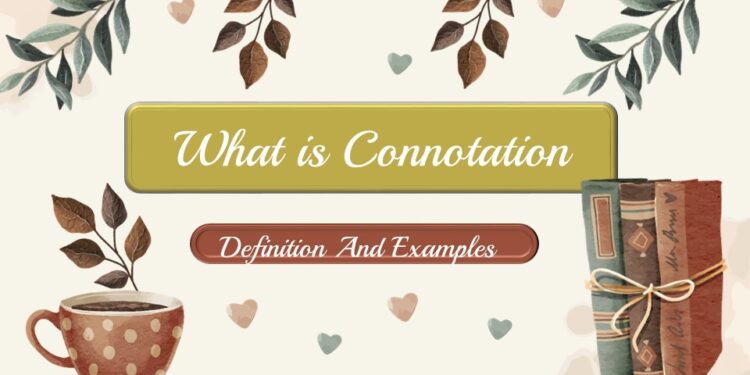What is Connotation Definition And Examples
Connotation refers to the emotional, cultural, and subjective associations that are attached to a word or phrase, beyond its literal or dictionary definition. It involves the implied or suggested meanings that a word carries, based on the context and the cultural or personal experiences of the individuals using or interpreting the word. In this essay, we will explore the concept of connotation in depth, its significance in language and literature, and its impact on communication and interpretation.
Connotation plays a crucial role in shaping the way we perceive and understand language. What is Connotation Definition And Examples While denotation refers to the literal or dictionary definition of a word, connotation adds layers of meaning and associations that go beyond the basic definition. What is Connotation Definition And Examples These connotations can be positive, negative, or neutral, and they can vary depending on the cultural, historical, or individual context in which the word is used.
Also Read-
- What is Conflict Definition And Examples
- What is Climax Definition And Examples
- What is Characterization Definition And Example
- What is Colloquialism Definition And Examples
Understanding the power of connotation is essential for effective communication and interpretation. Here are some key aspects of connotation:
- Emotional Associations: Connotation often carries emotional weight. Words can evoke positive or negative emotions based on the connotations they possess. For example, words like “freedom,” “love,” or “joy” have positive connotations, while words like “failure,” “betrayal,” or “disaster” have negative connotations. These emotional associations influence our perception and response to the words used.
- Cultural and Historical Context: Connotations can be influenced by cultural and historical factors. Certain words or phrases may carry specific connotations within a particular culture or time period. What is Connotation Definition And Examples For instance, the word “patriotism” may have different connotations in different countries, based on their respective histories and cultural values. Understanding these connotations is crucial for effective cross-cultural communication.
- Subjective Interpretation: Connotation is subjective and can vary from person to person. Different individuals may have different associations and experiences tied to specific words. Therefore, the interpretation of connotation can be influenced by personal experiences, beliefs, and attitudes. What one person perceives as positive, another might perceive as negative, based on their individual connotations.
- Literary Significance: In literature, connotation is a powerful tool used by writers to evoke emotions, create imagery, and convey deeper meanings. What is Connotation Definition And Examples Authors carefully choose words with specific connotations to enhance the tone, mood, and themes of their works. By utilizing connotation, writers can add layers of complexity and richness to their writing, engaging readers on an emotional and intellectual level.
- Advertising and Marketing: Connotation plays a significant role in advertising and marketing. What is Connotation Definition And Examples Advertisers carefully select words and phrases with positive connotations to associate their products or services with desirable qualities. What is Connotation Definition And Examples By leveraging the emotional and cultural associations tied to words, advertisers aim to create a favorable perception and generate desired responses from consumers.
- Word Choice and Communication: Connotation affects everyday communication as well. What is Connotation Definition And Examples The choice of words can influence how a message is received and understood. What is Connotation Definition And Examples Speakers and writers need to be aware of the connotations associated with the words they use to ensure effective communication and to avoid unintended misunderstandings.
Understanding the connotations of words allows us to navigate the nuanced layers of meaning in language. It helps us appreciate the richness and complexity of communication, both in spoken and written forms. What is Connotation Definition And Examples By recognizing the connotations attached to words, we can become more mindful and intentional in our language use, promoting clearer and more effective communication.
Examples Of Connotation
- “Home” – connotes feelings of warmth, comfort, and security.
- “Snake” – connotes danger, deceit, and treachery.
- “Whisper” – connotes secrecy, intimacy, and mystery.
- “Eccentric” – connotes uniqueness, creativity, and unconventional behavior.
- “Gorgeous” – connotes beauty, attractiveness, and admiration.
- “Cheap” – connotes low quality, inferiority, and lack of value.
- “Golden” – connotes richness, luxury, and success.
- “Coward” – connotes weakness, fearfulness, and lack of bravery.
- “Rebel” – connotes nonconformity, defiance, and resistance.
- “Melancholy” – connotes sadness, introspection, and a bittersweet feeling.
Conclusion
Connotation adds depth and complexity to language by incorporating emotional, cultural, and subjective associations to words beyond their literal definitions. What is Connotation Definition And Examples It influences how words are perceived, understood, and interpreted, playing a significant role in effective communication, literature, and advertising. What is Connotation Definition And Examples Recognizing and utilizing connotation allows for more nuanced and impactful expression, fostering deeper connections with readers and listeners.
FAQ.
Q. Can a word have both positive and negative connotations?
Ans. Yes, a word can have both positive and negative connotations depending on the context or the perspective of the speaker and the audience. For example, the word “ambitious” can be seen as positive, denoting drive and determination, or negative, suggesting ruthlessness or a disregard for others.
Q. Is connotation the same as tone?
Ans. Connotation and tone are related but not identical. Connotation refers to the associations and emotions tied to a word, while tone refers to the writer’s or speaker’s attitude or feelings towards the subject matter. Connotation contributes to the overall tone of a piece of writing or spoken discourse.
Q. Can connotations change over time?
Ans. Yes, connotations can evolve and change over time due to shifts in culture, values, and societal attitudes. Words that once had negative connotations may acquire positive connotations, or vice versa, as language and society evolve.
Q. How can understanding connotation improve communication?
Ans. Understanding connotation allows individuals to choose words and phrases that align with the intended message and desired emotional response. It helps prevent misunderstandings and promotes clearer, more effective communication by taking into account the emotional and cultural associations tied to words.
Q. Are connotations universal or subjective?
Ans. Connotations can be both universal and subjective. Some connotations may be shared across cultures and languages due to common experiences or shared symbolism. However, individual experiences, personal beliefs, and cultural contexts also influence connotations, making them subjective to some extent.
















